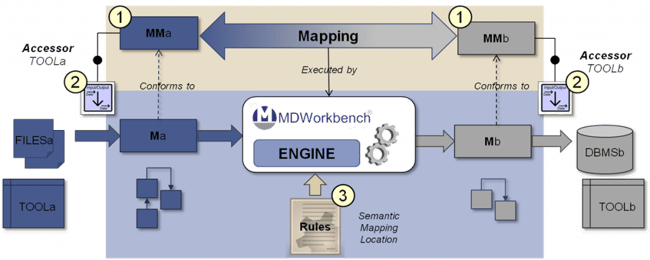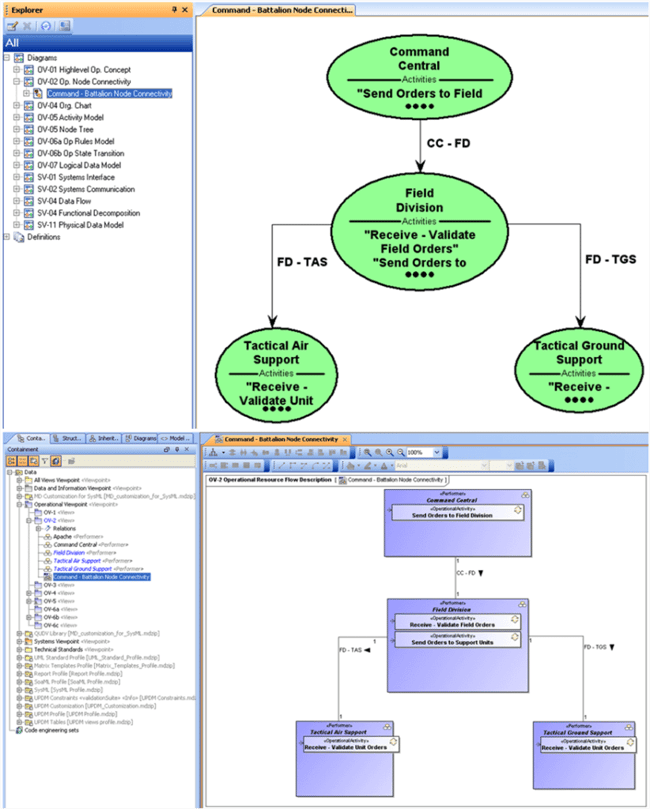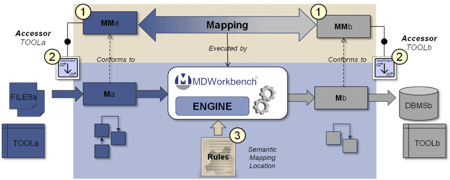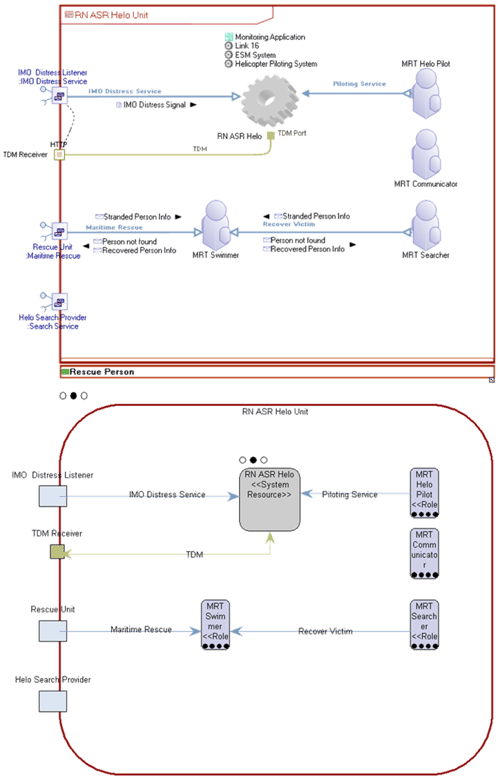SODIUS is a provider of interoperability solutions for Defense Architecture Frameworks. In the context of System Engineering, System of Systems architects design architectures in dedicated modeling software using Architecture Frameworks. During the lifecycle of projects, the design teams may exchange System Architecture models or may choose different modeling tools and/or associated meta-models. This fact increases the need for interoperability solutions that are able to Extract, Transform, and Inject models.
MDWorkbench: an Interoperability Platform
SODIUS is specialized in MDE (Model Driven Engineering) applied to the domain of System Engineering. SODIUS provides MDWorkbench, built on the Eclipse platform and based on EMF (Eclipse Modeling Framework), as a productivity platform for creating these solutions.
This application is dedicated to design solutions of automation and integration:
- Models Accessors: access to specific authoring tools and share data;
- Processing Models: develop model-driven rules to Transform Models, to Generate Codes, or to Produce Documents;
- Integrated Solutions: embed MDWorkbench capabilities to your own platform.
Design an Interoperability Solution with MDWorkbench
SODIUS' approach is to separate the data access processing (I/O) from the transformations that execute the required mappings. The design of an interoperability solution can be described with the following steps:
- Meta-models extraction to abstract data model (instead of syntax views);
- Data access implementation to enable tools access (read/write) in multiple, reusable ways to feed models (conforming to Meta-models);
- Transformation Rules design from semantic mappings.
SODIUS Expertise in Defense Architecture Frameworks
SODIUS' knowledge of the Defense Architecture Frameworks spans the following frameworks:
- DoDAF (Department of Defense Architecture Framework - USA) version 1.5 & 2.0;
- MODAF (Ministry Of Defense Architecture Framework - UK);
- NAF (NATO Architecture Framework - NATO) version 3.0 & 3.1;
- AGATE (Atelier de Gestion de l'ArchiTEcture des systèmes d'information et de communication - DGA France).
SODIUS worked with different authoring tools. These tools can implement many frameworks or can provide facilities to define parts of information that fills to architecture frameworks models. The following list is a representative set of modeling tools and frameworks for which SODIUS has already designed accessors and interoperability solutions:
- IBM Rational Rhapsody® - UML, and SysML;
- IBM Rational System Architect® - DoDAF, NAF, BPMN, and UML;
- IBM Rational DOORS® - Requirement Definitions;
- CORE® (Vitech®) - DoDAF, Cutomize Meta-models;
- MEGA® - DoDAF, and NAF;
- MagicDraw® (No Magic®) - UML, UPDM 1.0 & 2.0, BPMN, and SysML;
- Visio® (Microsoft Office®) - AGATE;
- Excel® (Microsoft Office®) ;
- Word® (Microsoft Office®) ;
- Enterprise Architect® (SparxSystems®) - UML, UPDM, SysML, and BPMN;
Moreover, the authoring tools provide to the architecture designers different diagram methodologies. The following list illustrates a set of diagrams for which SODIUS has already defined semantic mappings and transformation rules:
- IDEF: IDEF0 and IDEF1.x;
- EFFBD;
- N2-Diagrams;
- UML Diagrams: Class, Composite Structure, Package, Sequence, Statecharts, and Use Case;
- BPMN.
Cameo Inter-Op: a solution to exchange DoDAF models between MagicDraw and IBM Rational System Architect
Cameo Inter-Op® has been developed to allow MagicDraw® (No Magic®) and other products like IBM Rational System Architect® to communicate with each other and share data. It is a part of the No Magic's Cameo Suite® and is built on MDWorkbench. As part of services provided by Cameo Inter-Op, there are services to exchange DoDAF architectures between MagicDraw UPDM 2.0 (UML Profile for DoDAF and MODAF) and Rational System Architect DoDAF 1.5 Encyclopedia. This interoperability solution takes into account of the most important DoDAF Viewpoints:
- All Views (AV-1 and AV-2);
- Operational Views (OV-2, OV-3, OV-4, OV-5, OV-6b, OV-6c, and OV-7);
- System Views (SV-1, SV-2, SV-4, SV-5, SV-10b, SV-10c, and SV-11).
Cameo Inter-Op embeds an internal meta-model for each tools:
- Rational System Architect internal Encyclopedia Meta-model;
- UML 2.1 (Unified Modeling Language) for MagicDraw models profiled with UPDM 2.0.
This solution includes Accessors for the both tools that integrate diagram structures:
- Rational System Architect readers and writers for XML files and for the application with API's;
- MagicDraw readers and writers for MD Zip and MD XML authoring file format.
The following picture illustrates the transformation of an OV-2 diagram from Rational System Architect DoDAF 1.5 to MagicDraw UPDM 2.0:
NAF Interoperability Solution between MEGA and IBM Rational System Architect
SODIUS has developed a NAF Interoperability solution between IBM Rational System Architect® and MEGA®. The transformation rules has been defined to work with System Architect NAF Encyclopedias and MEGA NAF Libraries. With the aim to add other authoring tools in the future, this solution has been designed with an internal NAF 3.1 pivot meta-model. The following diagram shows the architecture of this solution:










Leave us your comment